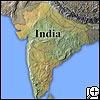So we're all stuck in this little cabin, this little coffin of ours. First class, not quite like first class on Singapore Airlines. There is no food cart or bar. But hey, there is a bathroom. Interestingly enough, it's a hole in the floor of the train and you just do your duty and it lands on the train tracks and the wonderful aromatic fumes invade the cart you're sleeping in. Originally I thought someone had crapped themselves to death. I thought someone needed to see a doctor or something.
A lot of things are going awry in India. A lot of the national parks have closed down because of the monsoon season. Yet the monsoon season hasn't come, so everything's unusually dry and most of the wildlife is in hiding. So we're trying to come up with another plan before we head on to Naag Panchami, the snake festival.
India's a very interesting place. When I look out the window and see all the people moving about, I actually think I can see the population grow. It's true! I have never seen so many people in my life. Everywhere. And just about every kid comes up to you and opens a basket and shows a cobra, so that novelty is wearing off.
There's no sense of personal space. People are in your face and don't know when to back off. But you have to understand that this is a very different culture, especially when it comes to poverty. There's a substantial level of poverty here, and some people are extremely desperate. You have to remind yourself that that's the situation, that no one wants to do this, but you find that in the end you lose your compassion because you have someone that will stand by you for an hour and beg money from you until you pay them. You can't escape them. You get onto a bus and then you hear "hello ... hello" and they're knocking and knocking and knocking and knocking. It takes some getting used to.
The food's not too bad. I like Indian food, but I've been eating pretty carefully.
We're all getting very anxious here in India, as the animal stuff isn't panning out. It's urban, urban, urban, urban — lots of crowded streets, lots of heat, lots of skinny cows. Hopefully this is gonna start panning out, and we'll find some interesting creatures. India — wonderful place, glad to visit, can't wait to go to many other wonderful places in this world as well.
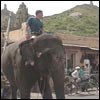
I got to ride an elephant with a mahout, an elephant person, this guy who's been working with elephants his entire life. Then I went with the mahout to bathe, and I was so excited. It was so cool to think I was actually gonna go down to the river with the mahouts and participate in the whole bathing process, where you scrub the elephants down. And then we get to what is supposed to be a lake and it's all dried up and green with refuse — the thing has diapers, broken glass and mannequin heads in it. And all I'm thinking is liver flu. So I ended up ballerina dancing my way across a mirage to get to the elephant. It was just so not what I had in mind. I had envisioned this sort of pristine river, getting in there and having fun, and there was no way I was going to expose any orifice to this water, because I don't need to get sick.
I did a little bicycle riding in Jaipur — a beautiful pink city — and almost got run over by lorries two or three times. Then a whole bunch of schoolchildren decided to stone me I won't forget that! I guess the only thing that will top that off is if someone slips me a mickey and harvests one of my kidneys while I'm sleeping. Boy, I'm jaded, huh?
This trip has been one of many ups
and downs, particularly in my intestinal tract. It's been a tough
journey. I have enjoyed my experience in India, but it's been very hard.
Especially on the animal front.
Unlike many of the other places that we've gone to all around the world,
in India you're very limited when it comes to finding wildlife in the
wild. For example, the time of year that the Naag Panchami festival
takes place is not the time of year when the national parks are open. So
we've had some trouble obtaining access to wildlife. But we've had great
opportunities to experience the urban side of India, which includes
crowded cities, lots of diesel smoke, lots of cows, a good dose of
reality when it comes to seeing poverty and stuff like that. Things are
changing, though, and the last few days have been excellent.
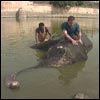
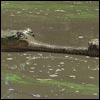
We just finished working at the crocodile bank in the Irula snake
cooperative, and that was a wonderful experience. I got to work with a
gharial, an extraordinarily rare and very unusual crocodilian that I've
known about since I was a child but had never before seen firsthand. I
actually got to experience these animals at every stage of life, from a
hatchling to an adolescent to a 3- or 4-meter-long adult that I fed
fish. To see an animal that you know is one of the rarest reptiles in
the world and actually have it come up and take fish from you is a
wonderful experience. And then I got to help relocate a female
crocodile, which was amazing, too. But the trip got even better because
the next day we hooked up with the Irula. The Irula people spend their
lives and their livelihood extracting snakes from snake dens and then
extracting venom from those snakes. That venom is then turned into
anti-venom, which is used throughout India.
Now, in India it can be very challenging not only to have access to
wildlife but to work with wildlife. There are lots of rules and
regulations in India, some that we've never encountered before in any
other country. And it's not uncommon that back in the office when
they're setting all this stuff up everything seems to be OK, but then
when you're out in the field, you discover it's a different story when
it comes to making contact and getting permission from the park and
forestry and wildlife service to have hands-on work with wildlife.
So on our way to the Irula cooperative, I'm very paranoid. Everything so
far on our trip has started out as yes's and ended up as no's.
"Yes, don't worry, you're going to get to India no problem."
OK, and then we get to India and we have tons of problems. And I'm
getting more and more paranoid because I think everything's going to go
wrong.
Then we get to the cooperative, and we're trying to set up and ask the
folks if we can participate — Can Jeff work with you? Can he help you?
— and they shake their heads. And I keep trying and ask, "Can I
help you? I really want to learn from you. Can you teach me?" And
still I get the head-shake. Now I'm thinking, "Where are we going
wrong?" And then someone tells me, "Oh, this means yes."
I'm like, "You mean we're OK?"
So finally we're in like Flynn, and we're in this big snake pit and it's
time for me to show my stuff. They're going to let me do what no other
visitor or herpetologist has done in many, many years because of rules
and regulations — they're going to let me milk some snakes.
But first we go out and capture cobras. It was the first time I've
actually captured a wild spectacle cobra — it was a spectacle to say
the least. Then we head back to the cooperative and the workers give me
the cobra to milk. It was gorgeous — 2 meters long — and the whole
milking process was amazing. It's so cool to see the venom drip into the
vial.
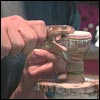
And next they give me a Russell's viper. Now I've read about Russell's
vipers, and I know they're very cantankerous, and although I've handled
many venomous snakes in my life, this is the first time I've ever
handled a Russell's viper, never mind milk one. But I'm not going to
tell the Irula that because I don't want to blow this.
Finally, the time comes and I pull this thing out of the tub. I put him
on the table, and I'm talking and I want to look like I know what I'm
doing — and I do know what I'm doing, but it's my first time with this
particular type of snake. Everything's going good so far, and then
suddenly this thing has a grand mal seizure in my hand. I'm trying to
look cool, but I'm this close to having to change my underpants.
Needless to say, in the end it all worked out fine. I got a little snake
venom on my hand, which caused some irritation, but nothing big. It was
a great experience.
So our visit to the Irula cooperative is a nice step to what we're doing
now, which is our last official train ride, the longest of them all,
14-plus hours in this little curtained caboose, as we head on down to
Bahti Shrila for the snake-worshipping festival Naag Panchami. Our plan
is to get to experience this festival and look at both the positive and
negative sides of it. Hopefully tomorrow will be the big payoff, and
we'll have a real holistic herpetologically wonderful experience!
I just finally finished at the Naag
Panchami festival. It was an extraordinary experience, but not for the
claustrophobic. It was basically a squirming wall of humanity — about
100,000 people winding their way up and down streets replete with cobras
and rattlesnakes and dancing people and music and vermilion powder
(yeah, there was some vermilion powder thrown around). It was amazing.
For a while it was hot and tedious and we were waiting to see what the
big deal was. Yesterday was interesting when we actually saw them
weighing and measuring the snakes. But then suddenly we got pulled into
the crescendo and we were dancing with all these people and these guys,
I guess they'd won fourth place for the tallest standing cobra, wrapped
a bandanna round me and slapped some vermilion powder on me and blessed
me with some ochre powder. It was a really euphoric experience.
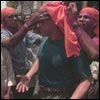
It was probably the most welcomed I've ever felt in India, and I'm glad
I went to this festival. It has been on my mind since I was about 9
years old, when I was saw a picture of "Naag Panchami, the Indian
festival," in some old picture book. I've been trying to get there
for 20-something years.
I went there with mixed feelings, because part of me is curious to see
how these people interact with snakes, wants to know why they're doing
this, why they take these snakes out of the environment, and wants to be
able to see up close these snakes that I would never have a chance to
see on my own. The other part, the ethical side when you turn my little
crispy wheat over and the sugar's tucked underneath, starts to wonder:
Is this fair to the snake? What kind of message does this send if I'm
going to show this on TV?
I'm a conservationist and I care about natural history, especially when
it comes to reptiles and amphibians, and here they are taking these
animals out of the wild for a week at a time. Well, I think the best
person to sum it up was an Indian herpetologist who said at least in
this individual village Bahti Shrila, they are very careful about
handling the snakes.
In other places in India, it's a lot more controversial because they
have problems with people trying to force-feed the snakes milk or rice.
To do that, they remove the snakes' fangs, and there's a high level of
mortality among the snakes.
In Bahti Shrila, the mortality rate very low. In fact some people have
told me that they've caught the same snakes year after year after year.
This is where the Naag Panchami originated. The festival has been going
on in this village for over 1,000 years. And going back to what that
herpetologist said, basically, he put it this way: Yes, there is some
impact. Sure, there's stress on the snakes and there even might be some
snakes that will die from this, but in India if people weren't
worshipping these snakes, and honoring them to pay tribute to Naag Devta,
the serpent god, and via Naag, the other Hindu gods, then there would
probably be no snakes because they'd be killed. Simply put, this
festival represents a way for these people to live with snakes and try
to find some harmony in an environment where there are venomous animals
around them.
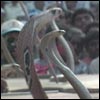
So yes, I'm glad I went. I am so glad I experienced the Naag Panchami;
it was everything I thought it was going to be and more. And I've left
with a better feeling about this particular festival in this region. I
mean, I'll admit I did see some sloppiness there, and there was that one
point when we were filming some stuff and these guys came around me with
these snakes and I was thinking, OK, what message is this going to send?
But overall it was a wonderful experience. India was a great adventure.
And while I'm glad to be going home (it was really tough here at times),
I'm also looking forward to coming back someday.
